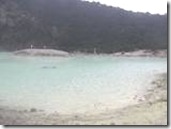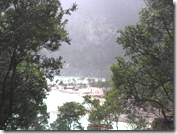The white crater dominating the view with some bluish appearances on some part adds exceptional dimension which tantalizes our sight; a contrasting picturesque to that of the crowded factory outlet. Certainly a more refreshing one! It took us two and half hours to get here and by the time we arrive at midday noon our stomach started to cry for immediate attention, the bitterly cold 500 meters walk could wait.

 You actually have an option to bring your own car to the peak, yet should you hesitate there is an open air small pick up available at a cost. The second options allow you to avoid costly damage onto your sedan’s undercarriage; it’s a peace of mind!
You actually have an option to bring your own car to the peak, yet should you hesitate there is an open air small pick up available at a cost. The second options allow you to avoid costly damage onto your sedan’s undercarriage; it’s a peace of mind!
I would estimate the temperature that day was slightly below 20 degree Celcius as you could tell it bites at 2,300 altitudes above sea level. Bandung (750 meter above sea level) average temperature in July is one of the lowest annually at 22.9 Celcius. Hence a wind jacket is an essential outfit of the day; however once you stroll down the crater your body heat suffices comforting warmth. Perhaps it was just due to a momentarily cloudy sky and blowing winds.

 Circling around the car park there are plenty of food stalls to choose for a warm and decent meal. But if you are worried about its hygiene you should stop earlier at large restaurant there are plenty of them as we
Circling around the car park there are plenty of food stalls to choose for a warm and decent meal. But if you are worried about its hygiene you should stop earlier at large restaurant there are plenty of them as we ll. We settled for a nice Bandung’s own culinary Mie Kocok or literary “Shaken Noodle” accompanied by none other than hot tea drink.
ll. We settled for a nice Bandung’s own culinary Mie Kocok or literary “Shaken Noodle” accompanied by none other than hot tea drink.
Now the fun began; as we ascending into the crater we were greeted by traditional Sundanese tembang accompanied by Kecapi musical instrument (Zither Ensembles). The ascend was quite steep yet it allows a panoramic  view of
view of  the crater itself as the sound of traditional instrument echoing heightened the Western Java’s unique atmosphere. The crater was found in 1856 by the famous German botanist Dr. FW.Juhnghun, who introduced the Malaria Pills industry to then
the crater itself as the sound of traditional instrument echoing heightened the Western Java’s unique atmosphere. The crater was found in 1856 by the famous German botanist Dr. FW.Juhnghun, who introduced the Malaria Pills industry to then  the Dutch Indies. Hypothetically the Dutch then mined its sulfur-rich sediments for Sulfur production which contributed 90% of all Dutch Indies till the Japanese invasion.
the Dutch Indies. Hypothetically the Dutch then mined its sulfur-rich sediments for Sulfur production which contributed 90% of all Dutch Indies till the Japanese invasion.
1920s marked the era of significant growth of Bandung city development as well as the center for many agro industry sectors including tea, coffee, rubber and cinchona (natural resources for Malaria Pills) plantations. Today the Kawah Putih has been established as one of West Java Ecotourism park, therefore since its inception in 1991 cleanliness is strictly monitored. No loitering allowed within the crater area!


No comments:
Post a Comment